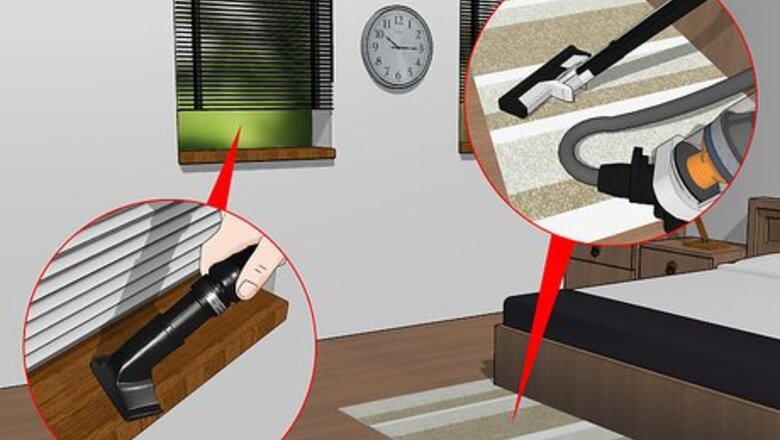
views
Removing Indoor Mites
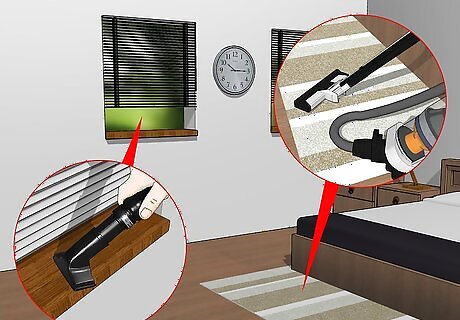
Vacuum up the clover mites to remove them from your house. If you see a group of clover mites inside your house, use a vacuum cleaner to suck them up. Then, vacuum the surrounding floors, walls, and windowsills to pick up any mites or mite eggs that you can’t easily see. Do not smash the mites. Doing so can leave behind a red, difficult to remove stain. To prevent further infestations, make sure you seal the vacuum cleaner bag before throwing it away. Clover mite eggs are tiny, dark red orbs.
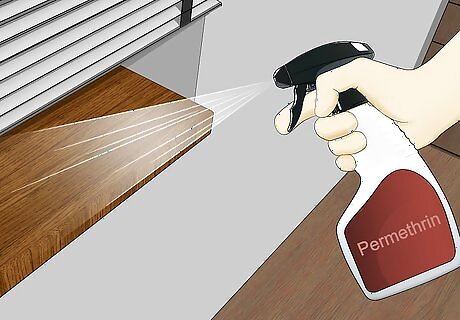
Spray the clover mites with insecticide to kill them. To kill a group of mites, spray them with an indoor-safe insecticide like permethrin, diazinon, bifenthrin, or chlorpyrifos. Make sure you apply the insecticide directly to the mites. Repeat the process as necessary until the mites are gone. Indoor-safe insecticide comes in both standard spray bottles and aerosol cans. You can find it online and at most home improvement stores. Insecticides can degrade the quality of air inside your home, so use them as a last resort.
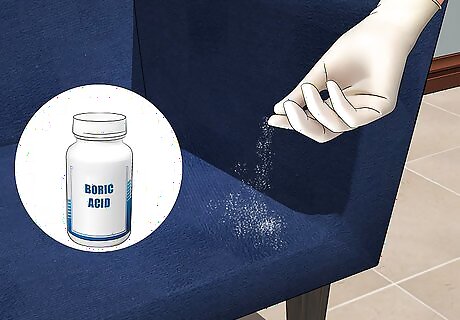
Sprinkle boric acid over your furniture to get rid of clover mites. Laundry detergents like Borax contain boric acid, a chemical compound that repels and eradicates clover mites. If you have powdered detergent, sprinkle it over your carpets, rugs, and pieces of furniture. Most clover mites will steer clear of the powder, but you can suck up any that get caught in it with a vacuum. If you have liquid laundry detergent, pour a small amount of the cleaning product into a spray bottle, dilute it with water, and spray it onto the clover mites.
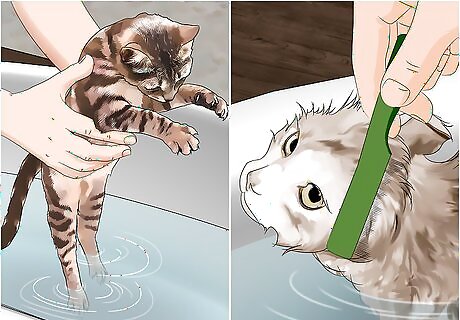
Remove clover mites from pets using soap and water. If your dog or cat gets clover mites in their fur, washing them thoroughly with soap and water should remove the infestation completely. For the best results, purchase an insecticidal soap from a home improvement, gardening supply, or pet store. Do not use standard insecticides on your pets, only insecticidal soap. Check the label of an insecticidal soap before using it on your pet. Most soaps are animal safe, but some may not be.
Eradicating Outdoor Mites
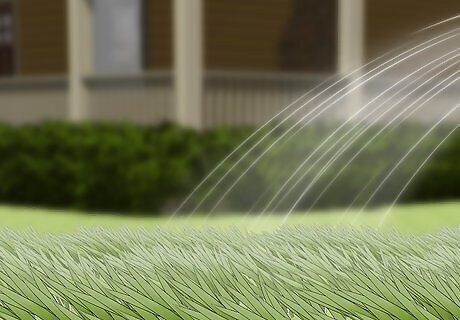
Water dry areas of your lawn where clover mites like to lay eggs. Clover mites often lay eggs on dry areas of land, such as those found around sun-exposed walls and the bases of evergreen plants. You can prevent these eggs from hatching by watering the dry patches thoroughly. Clover mite eggs look like small, maroon balls.
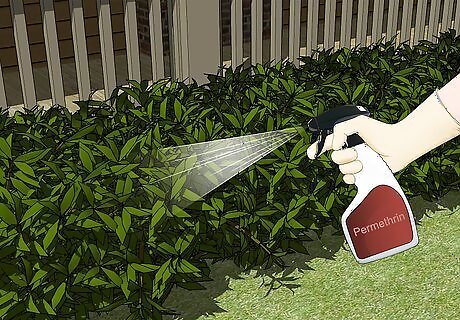
Coat individual plants with a liquid insecticide. If you notice clover mites crawling on your trees or other plants, treat the infested greenery with a liquid insecticide or acaricide. Apply the insecticide early in the morning or late in the evening to avoid scorching the plants, and follow the label directions to avoid under-dosing or overdosing. Use an insecticide like permethrin, cyfluthrin, tetramethrin, tralomethrin, chlorpyrifos, or malathion. You can find these online and at many big-box stores.
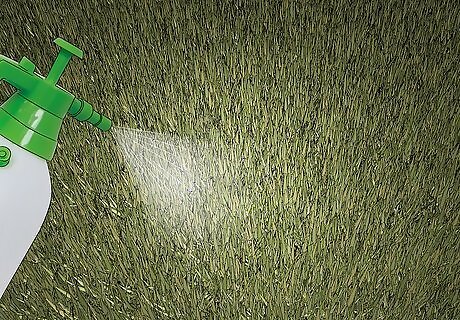
Treat your entire lawn with a broad-range insecticide. If you find clover mites in your home or on your plants, there’s a good chance your entire lawn is infested. If further inspection proves this to be true, spray your lawn with a broad-range insecticide like permethrin. For the best results, spray the insecticide using a water bottle equipped with a mist nozzle. Dilute granular and liquid pesticides with water according to the directions on their label. Make sure you spray your lawn in the early morning or evening so you don’t burn the plants. Look for broad-range insecticides online or at big-box stores.
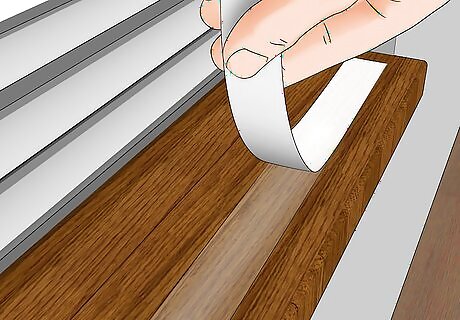
Lay down strips of double-sided tape to capture the clover mites. If you find clover mites near your house, place strips of double-sided adhesive tape along your exterior walls and in front of openings like windowsills. When mites crawl onto the tape, they will get stuck and eventually die. Once the tape becomes covered with dead mites, you can remove it and stick another one in its place. If you’d prefer, you can tape saran wrap to the house for a greater amount of coverage.
Repelling Outdoor Mites
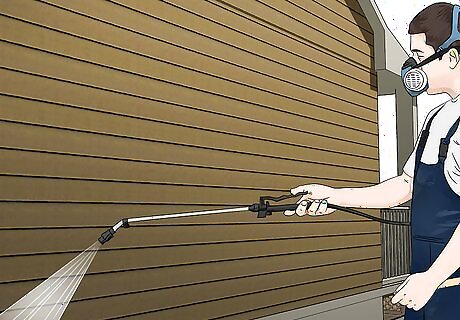
Cover your walls with insecticide to keep mites away. Spray a barrier of exterior control insecticide around the perimeter of your house that is at least 2 ft (61 cm) high. You may need to apply the insecticide multiple times to get the infestation under control. For the best results, try to apply your insecticide in the early morning or evening. You can find mite-killing insecticides like permethrin, cyfluthrin, malathion, tralomethrin, tetramethrin, and chlorpyrifos online and at big-box stores.
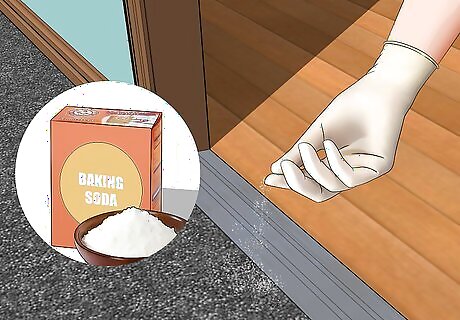
Sprinkle talc, diatomaceous earth, or baking soda around the entrances. Clover mites can get into your house using windows, doors, and foundation cracks. To prevent this, sprinkle a powdered substance such as talc, diatomaceous earth, or baking soda into and around these potential entrances. The powder cakes onto the clover mites, making it difficult for them to move and find food.
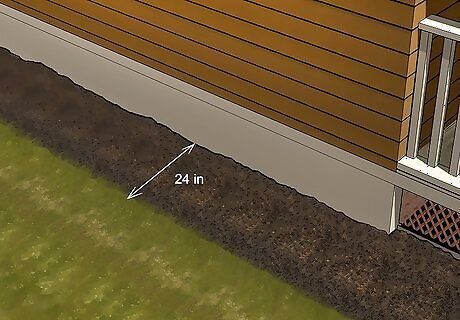
Dig up the ground around your house to remove the mites’ food source. If the clover mites won’t go away, dig up any grass, weeds, and foliage located within 24 in (61 cm) of your house. Clover mites need plant material to survive, and by removing it from the area around your home, you reduce the likelihood of further infestation. Cover these areas with a mite-repellant material like mulch or gravel to discourage the growth of weeds. If you choose to replant in the areas you’ve dug up, avoid plants that could attract clover mites, such as clover, dandelion, shepherd’s purse, daffodil, strawberry, salvia, alyssum, or primrose.

Plant foliage that does not attract clover mites. If clover mites keep coming back to your house, you may need to replace your current foliage with flowers and shrubs the mites aren’t interested in eating. Some plants clover mites are not attracted to include: Roses Geraniums Chrysanthemums Yews Junipers Spruces Arborvitaes




















Comments
0 comment